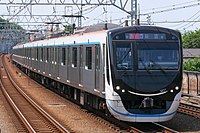Japan is a country that has been known for its high-tech and efficient transportation system. However, this transportation system is not only elite in accessibility and efficiency; it has also set a great example to the world about how to implement sustainability into the field of transportation. In fact, this transportation system heavily influences the fact that Japan’s per-capita greenhouse gas emissions are less than half of the United States’. The country has been able to promote this sustainable transportation through a combination of technology, government support, and citizen participation. The United States and many other countries around the world should seek to model their own transportation systems after this innovative Japanese one, in order to create a healthier and safer environment. In addition, these changes may also bring more efficiency and accessibility to the United States public transportation system.
The Japanese transportation system has greatly succeeded in the field of sustainability, much thanks to the innovation of leading companies in the industry. One key difference between Japanese transportation systems and others around the world is that those in Japan are mostly run my private companies. This has created easier, more accessible public transportation for all, as these companies work closely with the Japanese government to both fund new innovations and integrate separate rail systems. Japanese rail systems have also been built in a way that allows seamless modification to improve areas such as efficiency or sustainability; those in other nations such as the United States have not been built in such a way, leading to frequent issues and delays. One railway company that specifically seeks to improve the sustainability and functionality of Japanese railways is called JR East. JR East research ways to use renewable energy sources and create power storage systems to reduce wasted energy. They have also been striving to create an even faster than the famous Shinkansen train, which runs at almost 300 miles per hour. In addition to the railway system, Japan has also encouraged other sustainable forms of transportation such as biking. Only 10% of all transportation in Japan involves the use of motor vehicles, vastly reducing the CO2 emissions in the country.
One rail business in Japan that has set an example in sustainable practices is Tokyu Railways. In 2019, they became the first Japanese rail business to become a part of RE100, a global initiative bringing together thousands of companies striving become more sustainable. Only three years later, the company achieved its goal of powering all of its train lines with solar, geothermal, and hydropower energy. The average trip on a Tokyu train emits about 180 grams of CO2, 1000 grams less than an equivalent trip in a motorized vehicle. Over the course of an entire year, these reductions add up to saving nearly 800,000 tons of CO2 entering the atmosphere.
Japan has set the pace on sustainable transportation, specifically in the railway industry. However, this is only the beginning of the transition to renewable transportation practices, both in Japan and abroad. Several other rail companies in Japan, such as Tobu Railway and JR East, have followed the example of Tokyu Railways and have begun to reduce CO2 emissions. Further action and innovation is needed by other countries such as the United States in order to create a better future by reducing CO2 emissions by one of the biggest culprits, public transportation.
References:
https://www.triplepundit.com/story/2017/what-japan-can-teach-america-about-sustainable-transportation/19861
https://coordinates.ce.gatech.edu/japan-sustainable-development/sustainable-transportation-japan
https://www.railway-technology.com/features/tokyu-railways-goes-full-steam-ahead-on-its-sustainability-journey/


